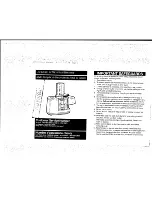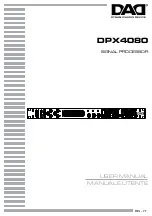
IRIS MODEL P520 APPLICATION MANUAL
Page 6
Polarity must be observed when wiring this connec-
tion (the positive terminal is on the top). This is an
isolated input, so two wires are required. Any DC
voltage from 7.5 to 30 may be used. The current
required will depend upon the voltage, because this
is a photocoupler interface circuit with a 3900 ohm
resistor feeding the LED light source.
For example: a 26 VDC voltage will result
in a current flow of 25/3900 = .0064 Amp.
If flame is being detected and the channels are
switched, the flame relay will remain energized for
one cycle regardless of the new set points, allowing
channel changes “on the fly,” so to speak. If the
new flame OFF set point is equal to or greater than
the current signal count, then the flame relay will
de-energize on the subsequent cycle.
The remaining two-pin terminal designated RE-
MOTE METER (to the left of the V.H. SEL termi-
nals) is for the remote meter connection. This out-
put is a current-driven signal that ranges from 0 to
20 mA for remote meters, and can be switched to a
range of 4 to 20 mA for DCS (distributed control
system) applications (refer to section 4-20mA RE-
MOTE OUTPUT). Connect the terminal marked
“positive” to the positive meter terminal. This cur-
rent signal can be used with a volt meter by feeding
the signal to a resistor connected to the ground. The
voltage developed across the resistor will follow
Ohm’s law V = IR.
For example: a 3-volt meter can be used
with a resistor of 3/.02 = 150 ohms, which
will result in a full-scale reading of 3 volts
for a 20mA output.
The terminals called TX+, TX-, RX+, and RX- (at
the bottom of the PCB) are used for the serial com-
munication link. They are also in pairs to accom-
modate “daisy chaining,” but the pairs are arranged
for twisted pairs instead of adjacent redundancy. The
serial communication is achieved by using ASCII
character code transmission at 4800 through the RS-
232 com ports on the host computer. The P520 uses
RS-422 data transmission which is over two, twisted
pairs that are differentially transmitted and received,
allowing long wire runs to be used through noisy
environments. An RS-232 to RS-422 converter must
be used to communicate with the P520, and the connec-
tions are made to the terminals marked TX+, TX-, RX+
and RX-. The transmitting, twisted pair goes to the TX
terminals, and the receiving, twisted pair goes to the RX
terminals.
Note: the terms “transmit” and “receive”
used here with respect to the P520 will
be reversed with respect to the RS-232
connection on the host computer. Refer
to later sections in this manual for a de-
tailed description of the software and how
it is to be used with the P520.
FIGURE 2 - WIRING VIEWING HEAD
Summary of Contents for P520
Page 1: ...FLAME MONITORING SYSTEM MODEL P520 SIGNAL PROCESSOR APPLICATION MANUAL ...
Page 12: ...IRIS MODEL P520 APPLICATION MANUAL Page 12 FIGURE 7 IRIS P520 I O MODULE SCHEMATIC ...
Page 35: ...IRIS MODEL P520 APPLICATION MANUAL Page 35 FIGURE 17 BASIC BURNER START CIRCUIT ...
Page 45: ...IRIS MODEL P520 APPLICATION MANUAL Page 45 NOTES ...







































